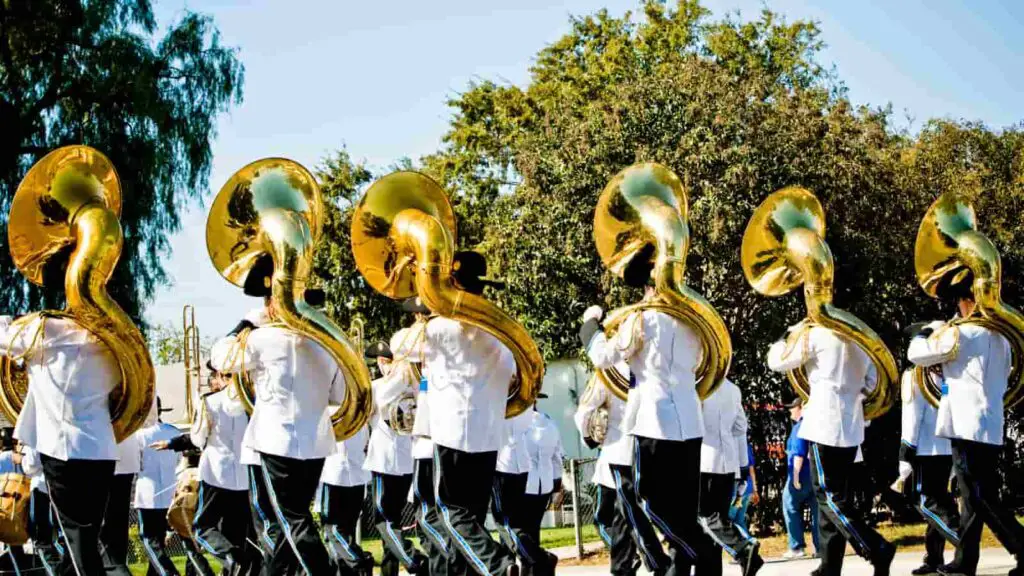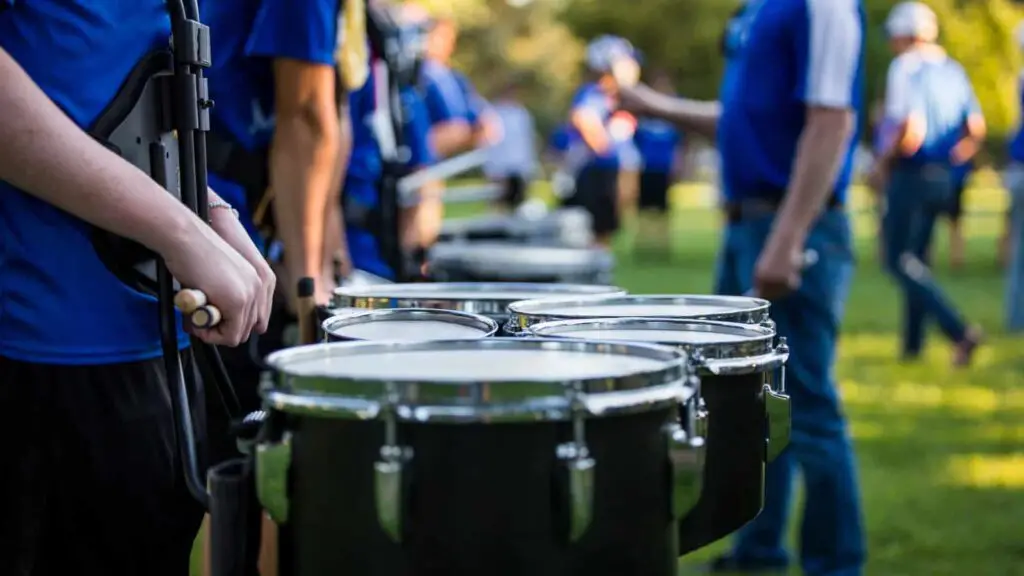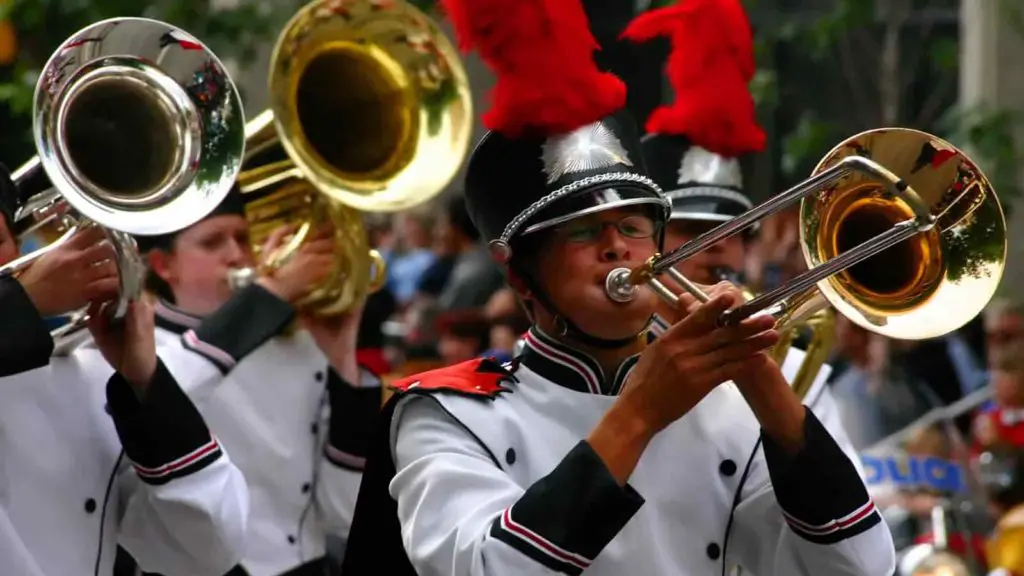Marching band instruments are known for their unique challenges and demands, requiring skilled musicians who can perform with precision and musicality while on the move.
Among the various instruments in a marching band, there are three that stand out as the hardest instruments to play in marching band: the euphonium/tuba, quads, and trombone. These instruments are heavy, difficult, to maneuver, and require extra practice and skill.
In this article, we will explore these instruments in detail, discuss the difficulties they present, and provide tips for mastering them.
Marching bands are a key part of many parades, halftime shows, and other musical performances. They bring energy, excitement, and visual spectacle to the audience. Behind the scenes, however, lies the hard work and dedication of the musicians who play these instruments.
1. Euphonium and Tuba
The euphonium and tuba are brass instruments known for their rich, deep tones that add a powerful foundation to the marching band’s sound. The euphonium is slightly smaller and higher in pitch compared to the tuba, but both instruments require similar techniques and skills.

Playing the euphonium or tuba in a marching band presents unique challenges. The sheer size and weight of these instruments can be physically demanding, especially when carrying them while marching or performing complex formations. Additionally, the embouchure and breath control required to produce a consistent sound on these instruments take time to develop.
To master the euphonium or tuba, it is crucial to focus on proper posture, breath support, and embouchure formation. Regular practice with long tones, lip slurs, and scales will help develop the necessary muscle strength and control. Seeking guidance from experienced teachers or joining a marching band program can greatly enhance the learning process.
2. Quads / Tenor Drums
Quads, also known as tenor drums or multiple toms, is a percussion instrument that adds a rhythmic punch to the marching band’s overall sound. Quads consist of multiple tom-toms of varying sizes, typically played with mallets or sticks.

Playing quads requires a high level of technical skill and physical strength. The drumline performer must not only memorize complex rhythms and patterns but also maintain precise synchronization with the rest of the band. The weight and arrangement of the drums demand excellent coordination and endurance.
To excel on quads, drummers should focus on building their technique through rudimental exercises, such as paradiddles, flams, and rolls. Developing a strong sense of rhythm and timing is essential. Regular practice with metronomes and engaging in ensemble rehearsals will enhance the drummer’s ability to synchronize with the band.
3. Trombone
The trombone is a versatile brass instrument capable of producing a wide range of tones and expressive effects. In a marching band, the
The trombone is a versatile brass instrument capable of producing a wide range of tones and expressive effects. In a marching band, the trombone section adds depth, power, and melodic lines to the overall sound.

Playing the trombone in a marching band comes with its own set of challenges. One of the main difficulties is the slide technique, which requires precise coordination between the player’s arm positions and air support. The player must accurately position the slide to produce the desired pitches, intervals, and glissandos.
To develop skills on the trombone, aspiring musicians should focus on mastering slide positions and developing a strong sense of intonation. Regular practice with scales, arpeggios, and etudes will help improve technique and musicality. Additionally, learning from experienced trombonists and participating in ensemble rehearsals will provide valuable guidance and exposure to different playing styles.
Conclusion
Marching band instruments require dedication, practice, and perseverance to master. The euphonium/tuba, quads, and trombone stand out as some of the most challenging instruments in this context. However, with the right techniques, guidance, and regular practice, musicians can overcome these difficulties and excel in playing these instruments.
By developing strong fundamentals, focusing on specific challenges, and seeking support from experienced musicians, aspiring marching band performers can navigate the complexities of these instruments and contribute to the overall success of their bands.
FAQs
Which marching band instrument is the most challenging?
The euphonium/tuba, quads, and trombone are considered among the most challenging marching band instruments due to their unique technical demands and physical requirements.
How long does it take to become proficient on these instruments?
The time required to become proficient on these instruments varies depending on individual dedication, practice frequency, and prior musical experience. It can range from several months to several years of consistent practice and instruction.
Are there any specific exercises for improving playing on these instruments?
Yes, there are specific exercises tailored to each instrument. For the euphonium/tuba, focusing on posture, breath support, and embouchure exercises is essential. Quads players should concentrate on rudimental exercises and developing coordination. Trombone players benefit from practicing slide positions, scales, and etudes.
What is the role of these instruments in a marching band?
The euphonium/tuba provides a solid foundation in the low brass section, quads add rhythmic complexity to the percussion ensemble, and the trombone adds melodic lines and harmonies to the overall sound of the band.
Where can I find resources to learn more about playing these instruments?
There are various online platforms, music schools, and marching band programs that offer resources, tutorials, and lessons for learning these instruments. Additionally, reaching out to experienced musicians or joining local marching bands can provide valuable guidance and support.
In this article, we explored the challenges and intricacies of three of the hardest marching band instruments: the euphonium/tuba, quads, and trombone. We discussed the specific difficulties each instrument presents and provided tips for mastering them. Remember, proficiency on these instruments comes with consistent practice, guidance from experienced musicians, and a passion for music. So, embrace the challenge, put in the effort, and enjoy the rewarding experience of playing these instruments in a marching band.
We hope this article has been helpful and informative for you in your musical journey. Please let us know if there is anything that we could add or change to make this article a better resource for our readers.
Please e-mail us at: [email protected] to let us know how we are doing!
Disclaimer: This post may contain affiliate links. We only recommend high-quality products that are used and recommended by real musicians. If you use these links to buy something we earn a small commission.
